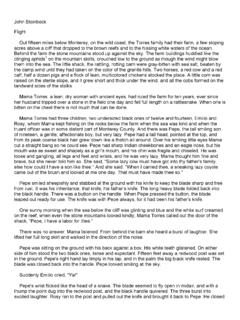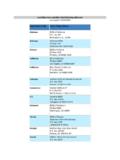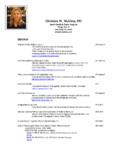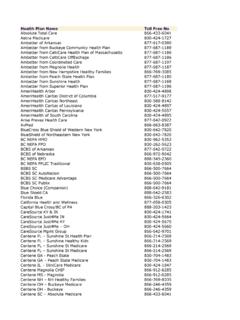Transcription of JohnSteinbeck
1 John Steinbeck Steinbeck redirects here. For other people with thissurname, seeSteinbeck (surname).John Ernst Steinbeck, Jr.(February 27, 1902 De-cember 20, 1968) was an American author of twenty-seven books, including sixteen novels, six non-fictionbooks, and five collections of short stories. He is widelyknown for the comic novelsTortilla Flat(1935) andCannery Row(1945), the multi-generation epicEast ofEden(1952), and the novellasOf Mice and Men(1937)andThe Red Pony(1937). ThePulitzer Prize-winningThe Grapes of Wrath(1939), widely attributed to be partof theAmerican literary canon,[2]is considered Stein-beck s masterpiece.
2 In the first 75 years since it was pub-lished, it sold 14 million copies.[3]The winner of the 1962 Nobel Prize in Literature, he hasbeen called a giant of American letters .[4]His works arewidely read abroad and many of his works are consideredclassics of Western of Steinbeck s work is set in southern and cen-tral California, particularly in theSalinas Valleyand theCalifornia Coast Rangesregion. His works frequently ex-plored the themes of fate and injustice, especially as ap-plied to downtrodden Early lifeJohn Ernst Steinbeck, Jr.
3 Was born on February 27,1902, inSalinas, California. He was of German, En-glish, and Irish descent.[5]Johann Adolf Gro steinbeck,Steinbeck s paternal grandfather, had shortened the fam-ily name to Steinbeck when he emigrated to the UnitedStates. The family farm inHeiligenhaus,Mettmann,North Rhine-Westphalia, Germany, is still today named Gro steinbeck. His father, John Ernst Steinbeck, served asMontereyCountytreasurer. John s mother, Olive Hamilton, a for-mer school teacher, shared Steinbeck s passion for read-ing and writing.
4 [6]The Steinbecks were members of theEpiscopal Church,[7]although Steinbeck would later be-come an agnostic.[8]Steinbeck lived in a small rural town,no more than a frontier settlement, set in some of theworld s most fertile land.[9]He spent his summers work-ing on nearby ranches and later with migrant workers onSpreckelssugar beet farms. There he became aware ofthe harsher aspects of migrant life and the darker sideof human nature, which supplied him with material ex-pressed in such works asOf Mice and Men.
5 [9]He alsoexplored his surroundings, walking across local forests,fields, and farms.[9]While working at Spreckels SugarCompany, he would sometimes work in their laboratory,which gave him time to write.[10]He also had consid-erable mechanical aptitude and fondness for making hisown repairs to things he owned.[10]TheSteinbeck Houseat 132 Central Avenue,Salinas, California,theVictorianhome where Steinbeck spent his graduated from Salinas High School in 1919and went from there to study English Literature atStanford UniversityinPalo Alto, leaving, without a de-gree, in 1925.
6 He travelled to New York City wherehe took odd jobs while trying to write. When he failedto have his work published, he returned to Californiaand worked in 1928 as a tour guide and caretaker[10]atLake Tahoe, where he met Carol Henning, his firstwife.[6][10][11]The two were married in January 1930 inLos Angeles, where, with friends, he attempted to makemoney manufacturing plastermannequins.[10]When their money ran out six months later, Steinbeckand Carol moved back toPacific Grove, California, to acottage owned by his father, on theMonterey Peninsulaa few blocks from the border of the city ofMonterey,California.
7 The elder Steinbecks gave John free housing,paper for his manuscripts, and from 1928, loans that al-lowed him to write without looking for work. During thisperiod of theGreat Depression, Steinbeck bought a smallboat, and later claimed that he was able to live on the fishand crab that he gathered from the sea, as well as freshvegetables from his garden and local farms. When thatdidn't work, Steinbeck and his wife were not above get-ting welfare, or rarely even stealing bacon from the localproduce market.
8 [10]Whatever food they had, they wouldshare with their friends.[10]Carol became the model for122 CAREERMary Talbot in Steinbeck s novelCannery Row.[10]In 1930, Steinbeck metEd Ricketts, who became aclose friend and mentor to Steinbeck during the followingdecade teaching him a great deal about philosophy andbiology.[10]Ricketts, usually very quiet, yet likable, withan inner self-sufficiency and an encyclopedic knowledgeof diverse subjects, became a focus of Steinbeck s atten-tion. Ricketts had taken a college class fromWarder , a biologist and ecological theorist, who would goon to write a classic early textbook on ecology.
9 Rickettsbecame a proponent of ecological thinking, in which manwas only one part of a great chain of being, caught in aweb of life too large for him to control or understand.[10]Meanwhile, Ricketts operated a biological lab on thecoast of Monterey, selling biological samples of small an-imals, fish, rays, starfish, turtles, and other marine formsto schools and the years 1930 to 1936, Steinbeck and Rick-etts became close friends. Steinbeck s wife began work-ing at the lab as secretary-bookkeeper.[10]Steinbeck him-self began helping out on an informal basis.
10 [10]Theyformed a common bond based on their love of musicand art, and John learned biology and Ricketts ecologi-cal philosophy.[10]When Steinbeck had emotional upsets,Ricketts would sometimes play music for him.[10]2 WritingSteinbeck s first novel,Cup of Gold, published in 1929,is loosely based on the life and death ofprivateerHenryMorgan. It centers on Morgan s assault and sacking ofthe city ofPanama, sometimes referred to as the 'Cup ofGold', and on the women, fairer than the sun, who weresaid to be found there.







